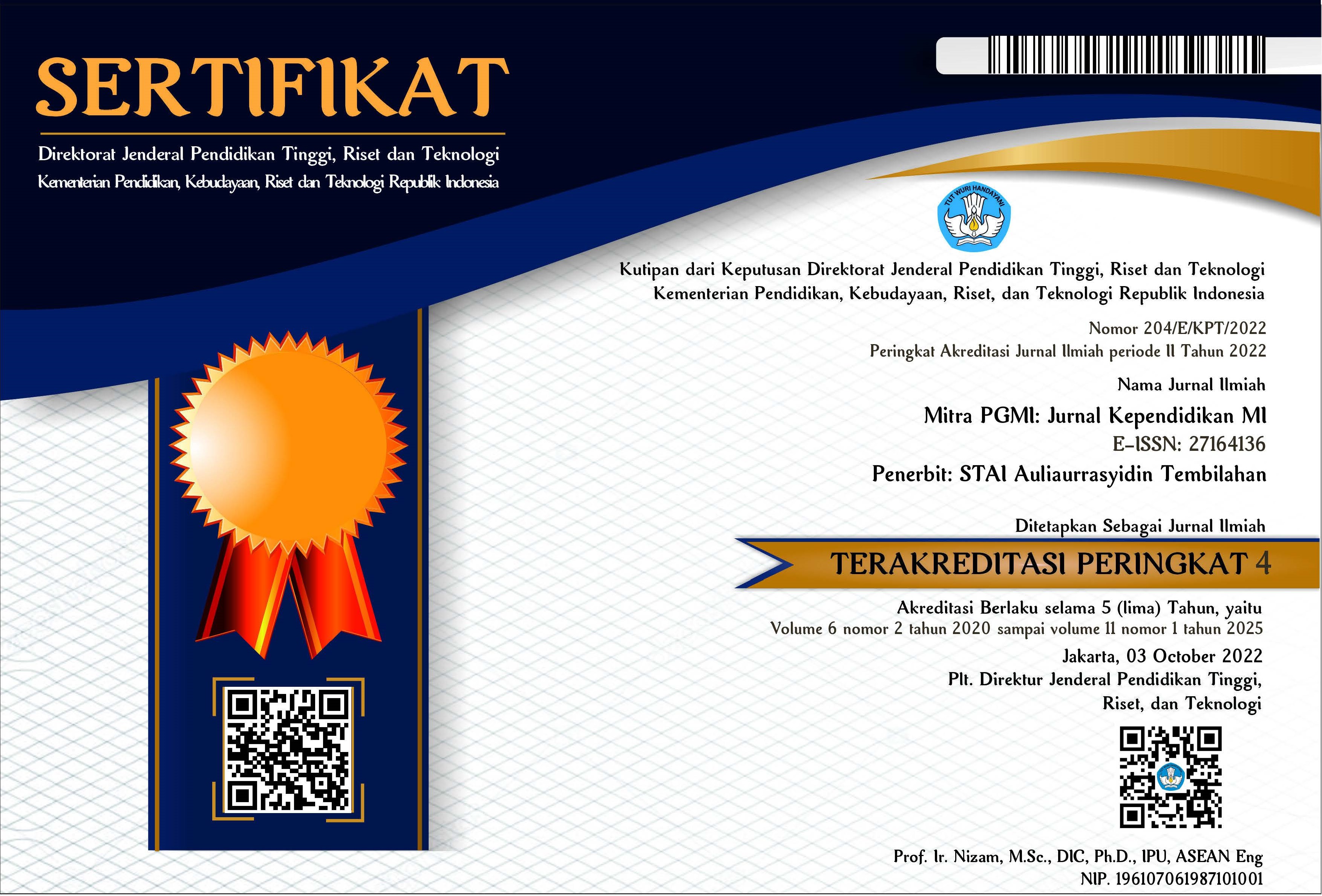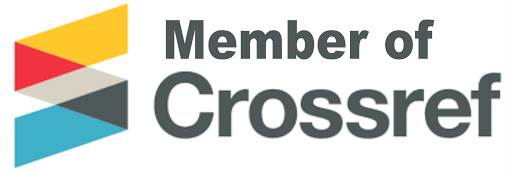Analysis of syntactic complexity in Elementary School aged 7-8 years
DOI:
https://doi.org/10.46963/mpgmi.v11i1.2598Keywords:
Elementary School, Syntactic Complexity, Language StimulationAbstract
This research aims to identify the profile of syntactic complexity abilities in elementary school aged 7 - 8 years in Surakarta. This research uses a quantitative approach with a survey-based descriptive design using multi-stage sampling which focuses on observing a single variable. Each respondent's sentence complexity will be calculated using analysis of language samples obtained from the results of the conversation, and the results will be analyzed descriptively statistically. The results show that interrogative, complex and compound-complex sentences are in the low group. Complete sentences, subject, predicate, object, information, declarative, simple, compound, active and passive are in the medium group. The syntactic abilities of children aged 7-8 years are mostly adequate, but have not yet reached their maximum potential. The role of teachers, speech therapists, and parents is important in optimizing this development through active language stimulation, syntactic structure practice, and early detection, taking into account environmental and social factors.
Downloads
References
Ahmad, M. (2021). Optimization of Learning Effectiveness through the Learning Environment and Learning Motivation for Students. . AL-ISHLAH: Jurnal Pendidikan, 13(3), 1546–1555.
Anggraini, N. (2020). Peran Orang Tua dalam Pengembangan Bahasa Anak Usia Dini. Indo-MathEdu Intellectuals Journal, 5(1), 1238–1248.
Astuti, M. T. (2024). Penegasan Kalimat pada Anak Usia 5 Tahun. Jurnal Bahasa, Sastra, Pembelajarannya, 7(2).
Darwin, D., Anwar, M., & Munir, M. (2021). Paradigma Strukturalisme Bahasa: Fonolofi, Morfologi, Sintaksis, dan Semantik. Jurnal Ilmiah SEMANTIKA, 2(02), 24-40.
Eliastiti, M. &. (2023). Peranan Sintaksis bagi siswa sekolah dasar. Jurnal Pendidikan dasar dan sosial HUmaniora, 2(7), 6102-6109.
Eliastuti, M. &. (2023). Peranan Sintaksis Bagi Siswa Sekolah Dasar. Jurnal Pendidikan Dasar dan Sosial Humaniiora, 2(7), 6102-6109.
Evans, J. L. (1992). Language sample collection and analysis: Interview compared to freeplay assessment contexts. Journal of Speech and Hearing Research, 343-353.
Febrina , L. (2020). Analisis Pemerolehan Sintaksis terhadap Anak Usia 4 Tahun di Komplek. Journal Sastra Indonesia 9 (3), 198-203.
Firmansyah, D. (2022). Teknik Pengambilan Sampel Umum dalam Metodologi Penelitian : Literature Review General Sampling Techniques in Research Methodology : Literature Review. Jurnal Ilmiah Pendidikan Holistik (JIPH), 1(2), 85-114.
Fitriyah, T. &. (2023). Pemerolehan Sintaksis Pada Anak Usia Dini. LINGUISTIK : Jurnal Bahasa Dan Sastra, 8(4), 718.
Hasim, E. (2018). Perkembangan Bahasa Anak . Jurnal Ilmu Kependidikan, 3(2), 91-102.
Khoirunnisa, I., Diniyah, T., & Noviyanti, S. (2023). Hakikat pemerolehan bahasa dan faktor pendukung pemerolehan Bahasa Anak . Journal of social Science Research, 4353-4363.
Korade, C. N. (2022). Monolingual and bilingual children’s production of complex syntactic structures. . Journal of Child Language, 51(2), 454–469.
Masitoh. (2019). Gangguan Bahasa Dalam Perkembangan Bicara Anak. Jurnal Elsa , 17(1).
Pavelko, &. O. (2023). A Sweet Tutorial to the SUGAR Method of Language Sampling. Perspectives of the ASHA Special Interest Groups., 32-49.
Prayoga, Y. A. (2013). Kemampuan Bercerita Siswa Usia 7-8 Tahun Berdasarkan Klasifikasi Kalimat Bahasa Indonesia Di Sdn Kalijudan Kecamatan Mulyorejo Surabaya. Skriptorium , 1(2), 119-127.
Rohmaningtyas, K. N. (2021). Kompleksitas kalimat pada cerpen karya anak dan cerpen karya remaja. Bapala, 8(6), 109-121.
Rumilah, S. (2021). Sintaksis Pengantar Kemahiran Berbahasa Indonesia. Cv. Revka Prima Media.
Sari, R. M. (2022). Analisis kesalahan sintaksisi Bahasa Indonesia dalam karangan. . PEMBAHSI, Jurnal Pembelajaran Bahasa Indonesia, 12(2).
Shanty, A. D., & Dewi, A. C. (2021). Analisis fonemik dan sintaksis pada anak usia 5-6 tahun di tk qurrota a’yun 01 kota pekalongan. Aṣ-Ṣibyān Jurnal Pendidikan Anak Usia Dini, 6(2), 179-186.
Southwood, F. &. (2004). Comparison of Conversation, Freeplay, and Story Generation as Methods of Language Sample Elicitation. Journal of Speech, Language, and Hearing Research,, 47(2) 366-376.
Suardipa, I. P. (2020). Proses Scaffolding pada Zone of Proximal Development (ZPD) dalam Pembelajaran. . Widyacarya, 4(1), 79–92.
Sugiyono. (2015). Metode Penelitian Pendidikan (Pendekatan Kuantitatif, Kualitatif, dan R&D) (p. 12). CV. ALFABETA.
Supit, S. (2023). Optimalisasi Pembelajaran Bahasa Anak Usia Dini Melalui Pendekatan Stimulasi Guru Pendidikan Agama Kristen. . Montessori Jurnal Pendidikan Kristen Anak Usia Dini, , 4(1), 10–24.
Tarmini, D. W. (2019). Sintaksis Bahasa Indonesia. Jakarta: UHAMKA, Jakarta.
Zakiyah, S. H. (2024). Perkembangan Anak pada Masa Sekolah Dasar. DIAJAR: Jurnal Pendidikan Dan Pembelajaran, 3(1), 71–79.
Zebua, U. C. (2024). Analisis struktur kalimat dalam menulis karangan teks persuasif di smp. . Jurnal Education and Development Institut Pendidikan Tapanuli Selatan, 12(3), 504–510.
Downloads
Published
Issue
Section
License
Copyright (c) 2025 Vira Amandita Saputri, Rizki Husadani, Kiyat Sudrajad

This work is licensed under a Creative Commons Attribution-ShareAlike 4.0 International License.
Authors who publish with this journal agree to the following terms:
1. Copyright on any article is retained by the author(s).
2. The author grants the journal, right of first publication with the work simultaneously licensed under a Creative Commons Attribution shareAlike 4.0 International License that allows others to share the work with an acknowledgment of the work’s authorship and initial publication in this journal.
3. Authors are able to enter into separate, additional contractual arrangements for the non-exclusive distribution of the journal’s published version of the work (e.g., post it to an institutional repository or publish it in a book), with an acknowledgment of its initial publication in this journal.
4. Authors are permitted and encouraged to post their work online (e.g., in institutional repositories or on their website) prior to and during the submission process, as it can lead to productive exchanges, as well as earlier and greater citation of published work.
5. The article and any associated published material is distributed under the Creative Commons Attribution-ShareAlike 4.0 International License








2.png)


